Enter the chronicle of the SMD (Surface Mount Device) screen saga, a narrative woven by the threads of visual advancement. In this article, we embark on a journey through the evolution of SMD screens, tracing their story from inception to their current role as pioneers in visual technology. This saga is not just a recounting of technical milestones but a testament to the transformative impact that SMD screens have had on reshaping how we perceive and interact with the visual world.
The Genesis of SMD Screens
The SMD Screen saga begins with the quest for a more efficient and compact display technology. The traditional methods of display manufacturing were bulky and limited in their applications. SMD screens emerged as a revolutionary solution, utilizing a surface-mounted assembly process that paved the way for sleeker, more versatile displays.
The genesis of SMD screens can be traced back to the integration of light-emitting diodes (LEDs) directly onto the circuit board. This innovation not only resulted in a reduction in size but also brought forth improvements in brightness, color reproduction, and overall performance. The stage was set for a visual revolution.
The Evolution of Pixel Perfection
As the saga unfolded, one of the key chapters was the relentless pursuit of pixel perfection. SMD screens evolved with advancements in pixel density and resolution, enabling the creation of displays with unparalleled clarity and sharpness. The journey towards pixel perfection transformed the landscape of visual communication, from consumer electronics to large-scale digital billboards.
High-resolution SMD screens became the canvas for artists, content creators, and designers alike. The ability to convey intricate details, vibrant colors, and lifelike images elevated the visual experience across various industries. Whether it was the vivid displays on smartphones or the mesmerizing visuals in advertising, pixel perfection became a hallmark of the SMD screen saga.
Versatility Unleashed
A pivotal chapter in the SMD screen saga was the unleashing of versatility. SMD screens broke free from the constraints of traditional displays, finding applications in diverse industries and environments. From the sleek screens of smartphones and televisions to the expansive displays in retail, SMD screens showcased their adaptability.
The versatility of SMD screens extended to areas like medical imaging, automotive displays, and even wearable technology. The compact design and high performance of SMD screens made them integral to the fabric of our daily lives. This chapter underscored the transformative power of versatility, turning SMD screens into indispensable tools for visual communication.
The Rise of Interactive Experiences
As the saga progressed, SMD screens ventured into the realm of interactive experiences. Touch-sensitive screens and gesture recognition technology became integral components, ushering in a new era of engagement. Interactive kiosks, educational displays, and collaborative workspaces embraced the interactivity that SMD screens offered.
The rise of interactive experiences expanded the scope of SMD screens beyond passive viewing. Users could now actively participate, touch, and manipulate content, blurring the lines between the digital and physical worlds. This chapter in the saga marked a paradigm shift in how we interacted with information and entertainment.
Advancements in Sustainability
A significant turning point in the SMD screen saga was the focus on sustainability. As environmental consciousness took center stage, the industry responded with advancements in energy efficiency and eco-friendly practices. SMD screens evolved to become more energy-efficient, contributing to reduced carbon footprints and aligning with global sustainability goals.
Manufacturers embraced responsible disposal practices, addressing concerns about electronic waste. This commitment to sustainability not only positioned SMD screens as technological marvels but also as responsible contributors to a greener future.
Conclusion
In concluding the SMD screen saga, we find ourselves in a visual landscape transformed by the brilliance of technological innovation. From humble beginnings, SMD screens have evolved into the driving force behind visual advancement. The chronicle of their journey is a testament to the power of ingenuity, adaptability, and a relentless pursuit of perfection.
As we reflect on the SMD screen saga, it becomes evident that these displays are not mere gadgets but enablers of connection, communication, and creativity. From enhancing the way we consume content to reshaping entire industries, SMD screens have left an indelible mark on the canvas of visual storytelling.
FAQs
Q1: What is the genesis of SMD screens?
A: The genesis of SMD screens lies in the quest for a more efficient and compact display technology. SMD screens emerged by utilizing a surface-mounted assembly process and integrating light-emitting diodes (LEDs) directly onto the circuit board.
Q2: How have SMD screens evolved in terms of pixel perfection?
A: SMD screens have evolved with advancements in pixel density and resolution, leading to displays with unparalleled clarity and sharpness. The pursuit of pixel perfection has transformed visual communication across various industries.
Q3: In what ways have SMD screens become versatile?
A: SMD screens have become versatile by breaking free from the constraints of traditional displays. They find applications in diverse industries, including consumer electronics, retail, medical imaging, automotive displays, and wearable technology.
Q4: How have SMD screens contributed to interactive experiences?
A: SMD screens have ushered in interactive experiences with the incorporation of touch-sensitive screens and gesture recognition technology. This has expanded the scope of SMD screens beyond passive viewing to active participation and engagement.
Q5: How have advancements in sustainability shaped the SMD screen saga?
A: Advancements in sustainability have made SMD screens more energy-efficient and eco-friendly. Manufacturers have embraced responsible disposal practices, contributing to reduced electronic waste and aligning with global sustainability goals.


